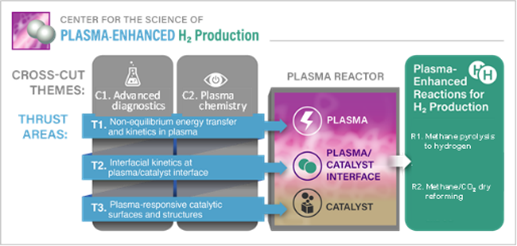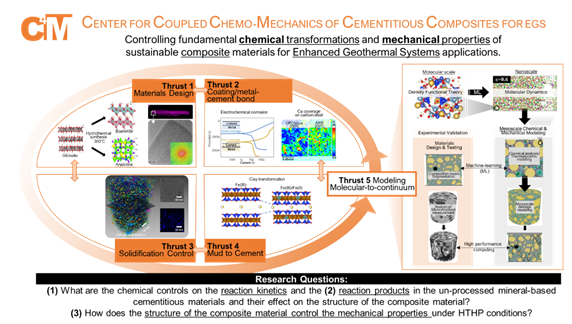Energy Earthshot Research Centers (EERCs)
The Energy Earthshot Research Centers (EERCs) establish a new era of cross-office research cooperation. Launched in FY 2023, the EERCs will build off the success of SC’s Energy Frontier Research Centers (EFRCs) and the Scientific Discovery Through Advanced Computing (SciDAC) program, bringing together multi-investigator, multi-disciplinary teams to perform energy-relevant research with a scope and complexity beyond what is possible in standard single-investigator or small-group awards. The EERCs will address the key basic research challenges facing the Energy Earthshots with relevance to applied research and development activities.
Each Center is led by a DOE National Laboratory with partners across the U.S. from academia and industry. These Centers are composed of collaborative research teams spanning multiple scientific and engineering disciplines. The DOE National Laboratories have a proven track-record leading multi-investigator, multi-disciplinary teams necessary to address the complex research challenges to realize Energy Earthshot stretch goals. Each Center will address key research challenges of one of the initial six Energy Earthshots.
Map of EERC Institutions

Hydrogen Shot EERCs
CIWE · Center for Ionomer-based Water Electrolysis
Director: Dr. Adam Weber
Lead Institution: Lawrence Berkeley National Laboratory
CIWE aims to improve hydrogen generation by analyzing the use of ion-conducting polymers (ionomers) for low-temperature electrolysis, the process of generating hydrogen from water by applying electricity. The project combines advanced characterization and modeling for a fundamental understanding of how the morphology and chemistry of ionomer interfaces can affect the durability and efficiency of water electrolyzers under realistic operating conditions.
PEHPr · Center for the Science of Plasma-Enhanced Hydrogen Production
Director: Dr. Yiguang Ju
Lead Institution: Princeton Plasma Physics Laboratory (PPPL)
PEHPr aims to produce sustainable hydrogen via catalysis and plasma, the electrically charged fourth state of matter, which would ultimately be created with renewable electricity. The project will advance fundamental understanding of energy flow and chemistry in plasmas and plasma-surface interactions and could lead to a paradigm shift in clean hydrogen production by developing energy-efficient plasma-mediated catalytic processes for low-cost electrified hydrogen production.

Long Duration Storage Shot EERCs
DEGREES · DEGradation Reactions in Electrothermal Energy Storage
Director: Dr. Judith Vidal
Lead Institution: National Renewable Energy Laboratory
DEGREES will advance fundamental understanding of materials used for long-duration energy storage in support of a future-ready decarbonized grid. Coupling theory, powerful computational tools, and novel characterization approaches, this research will (1) provide understanding of thermal energy storage material degradation, (2) work to control the degradation and instabilities, and (3) design improved materials that are durable and high-performing.

Carbon Negative Shot EERCs
RESTOR-C · Center for RESTORation of soil Carbon by precision biological strategies
Director: Dr. Susannah Tringe
Lead Institution: Lawrence Berkeley National Laboratory
RESTOR-C will develop plant- and microbe-based strategies to increase accumulation of organic carbon in soil. The project will apply cutting-edge molecular and computational methods to increase carbon uptake by plants, facilitate transport to soil, and enhance its persistence in soils in the context of agricultural systems.

 Terraforming Soil EERC
Terraforming Soil EERC
Director: Dr. Jennifer Pett-Ridge
Lead Institution: Lawrence Livermore National Laboratory
The Terraforming Soil Energy Earthshot Research Center (EERC) will study biological and geological solutions to accelerate scalable, affordable carbon drawdown in the United States’ 166 million hectares of agricultural soils. Research objectives include gene-edited plants and microorganisms that accelerate carbon sequestration, strategies that encourage soil mineral-organic interactions, and models that predict carbon durability in small soil pores as well as regional-scale estimates of locations with opportunities for increased soil carbon removal.
Enhanced Geothermal Shot EERCs
C4M · Center for Coupled Chemo-Mechanics of Cementitious Composites for EGS
Lead Institution: Brookhaven National Laboratory
C4M advances the development of geothermal energy in the US by elucidating and controlling the chemical transformations and mechanical properties of sustainable composite materials for Enhanced Geothermal Systems, with the overarching goal of reducing their costs by 90% by 2035.

CUSSP · Center for Understanding Subsurface Signals and Permeability
Lead Institution: Pacific Northwest National Laboratory
CUSSP aims to develop the ability to predict and control fluid flow through fracture networks in enhanced geothermal systems (EGS). This requires understanding how fluid interaction with hot rocks under stress can change the flow behavior over time and learning how to detect and monitor those changes remotely by developing advanced real-time sensing tools.
Floating Offshore Wind Shot EERCs
ACE-FWICC · Addressing Challenges in Energy: Floating Wind in a Changing Climate
Lead Institution: Pacific Northwest National Laboratory
ACE-FWICC will develop new understanding of key phenomena associated with meteorological and oceanic conditions and use scientific machine learning to swiftly advance the design and control of floating offshore wind turbines and farms and their integration with the grid.

FLOWMAS · Floating Offshore Wind Modeling and Simulation
Director: Dr. Michael Sprague
Lead Institution: National Renewable Energy Laboratory
FLOWMAS: Through a combination of high-fidelity modeling and high-performance computing for floating offshore wind energy, researchers will create next-generation data-driven surrogate models and a new understanding of the floating offshore wind energy system, including how climate change will impact offshore wind resources, the physics of floating wind farm and turbine wake dynamics, and the loads and dynamics of floating wind turbines during operational and extreme events.
Industrial Heat Shot EERCs
C-STEEL · Center for Steel Electrification by Electrosynthesis
Director: Dr. Brian J Ingram
Lead Institution: Argonne National Laboratory
Today, producing iron from ores is an energy-intensive process that requires temperatures greater than 2500 °F and accounts for 1% of all industrial carbon emissions in the US. C-STEEL envisions a future that harnesses the inherent efficiency of electrochemical processes that require low (or no) heat input for scalable, sustainable, and low-cost industrial iron manufacturing. The Center aims to overcome the fundamental science challenges that limit electrodeposition of purified iron.
NEETER · Non-Equilibrium Energy Transfer for Efficient Reactions
Director: Dr. David Sholl
Lead Institution: Oak Ridge National Laboratory
NEETER focuses on replacing bulk steady-state heating with electrified processes that deliver spatially and temporally localized pulses of heat for catalytic chemical processes. NEETER’s overarching goal is to leverage transient temperature and pressure conditions in non-equilibrium chemical processes following unconventional reaction pathways with high energy and atom efficiency, and allowing electrification of processes that currently generate large greenhouse gas emissions due to heating.
Contact: EERC@science.doe.gov


